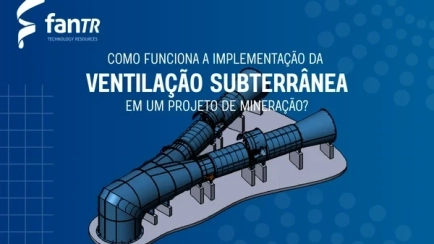
Explore how the implementation of Underground Ventilation works in a mining project



Implementing underground ventilation in a mining project requires consideration of several crucial points that begin with the mine design.
When developing this project, local geology is taken into account, the type of ore to be extracted, its distribution, the topography of the region, the number of people involved in the operation, and the equipment used, among other factors.
Based on this information, it is possible to determine the expected useful life of the mine and adequately size the underground ventilation system, ensuring an adequate supply of fresh air for the health and safety of workers at all stages of the exploration process.
Therefore, by having accurate information about the mine it is possible to evaluate and determine the best underground ventilation system, ensuring a safe working environment, with adequate circulation of fresh air and minimizing risks related to air quality and the presence of harmful gases or particles.

Photo: Aripuanã Project by Nexa Resources
For an efficient implementation of underground ventilation, alignment between the teams involved is essential to ensure that the required resources are available. Mine staff must have access to all relevant information about exploration, and ventilation engineers must collaborate with operations planning engineers. It is important to emphasize that ventilation systems are designed for the most critical scenarios, but do not necessarily need to operate in these conditions all the time.
The determination of ventilation systems must be made according to your specific objectives and are subdivided into auxiliary ventilation or secondary ventilation and main ventilation commonly called exhaust fans.
Secondary or auxiliary ventilation
These are pieces of equipment commonly installed inside the mine and are smaller in size, which consequently blocks a smaller area in the gallery, but they play a crucial role in distributing air between the exploration galleries.


Photo: Secondary or Auxiliary Ventilation
To position this equipment appropriately, it is necessary to take into consideration all the characteristics of the exploration. For example, in a bottom gallery, where there is only one entrance and exit for people and vehicles, it is possible to use secondary ventilation to help supply air. However, it is essential to consider the gallery geometry, as simply injecting air into the inlet is not sufficient due to the confined environment, which prevents the formation of a continuous flow.
In this context, it is necessary to use ducts that carry clean air directly to the bottom of the gallery, avoiding mixing with stale air. Furthermore, it is essential to clean the system from the inside out, to ensure efficient ventilation.
Main Ventilation – Exhaust Fans
As the mine deepens and expands on several working fronts, it becomes necessary to drill ventilation raises (chimneys) that directly connect the surface to the lower levels, which can act as adduction raises or exhaust raises.
When used as adduction raisers, the main advantage is to supply clean air directly to a certain depth level, allowing the air to arrive at a lower temperature since it has not absorbed the heat from the entire descent of the ramp. This also reduces the pressure in the mine, resulting in energy savings as the effort required to generate airflow is reduced.
When raises are used as extractors, there are two ways of application: as boosters or as surface extractors. This equipment plays an extremely important role since, in many cases, the entire mine airflow must pass through it.


Photo: Primary Ventilation
The exhaust fan equipment installed in the ventilation raises is larger and has more installed power. Given its importance, it is recommended to position more than one exhaust fan whenever possible. This configuration brings several advantages, such as the ability to keep the mine operating with 50% airflow in the event of maintenance or problems with one of the equipment. This ensures that fresh air continues to circulate, avoiding a complete shutdown. If only one piece of equipment is used and intervention is required, the airflow in that area of the mine will be interrupted.
It is essential to remember that, according to NR 22, the oxygen supply inside the mine must not be less than 19% in volume in environments where people traffic or work. This measure is essential to ensure the safety and well-being of underground workers.
Share your questions and ideas with us by contacting us below.